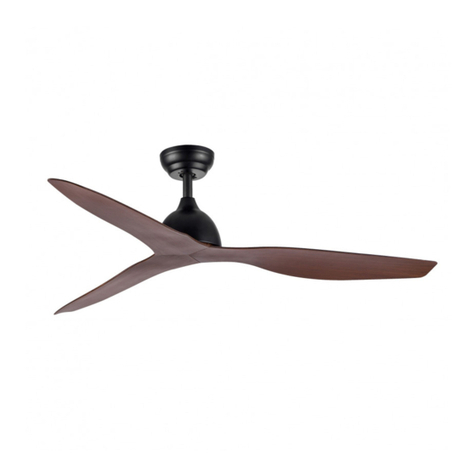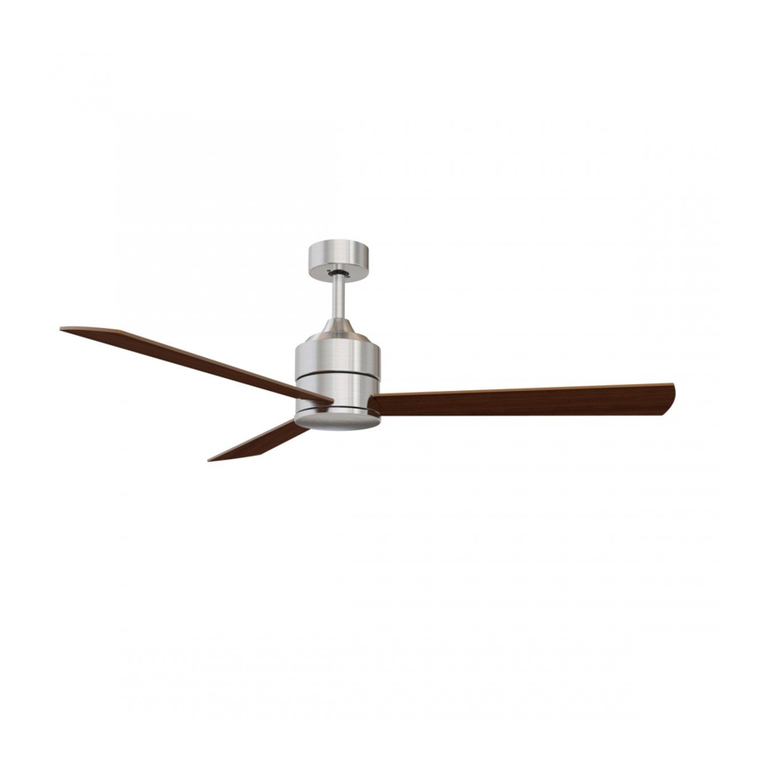
hofflights.com
4
MANUAL DE INSTALACIÓN
ZANZIBAR
IMH-099 v.01
Gracias por comprar este producto de calidad. Para asegurar su uso y la seguridad, por favor lea y conserve este manual
antes de utilizar el producto.
W
Motor V RPM
Airflow
(CFM) ØxH (mm.) Kg
5.0120.0222 26 100-240 190 4000 1320x305 5
5.0120.0211 26 100-240 190 4000 1320x305 5
WARRANTY
MOTOR
10
2,3
m
IP20
DC
MOTOR 5SPEED
SOLID
WOOD
BLADES
15-20
m2
GRACIAS POR SU COMPRA
SEGURIDAD
1. Para evitar posibles choques eléctricos, corte la luz desde la caja de fusibles o magnetotérmicos antes de empezar con
la instalación del ventilador, su puesta en marcha o la instalación de los accesorios.
2. Lea las instrucciones y los consejos de seguridad con atención antes de instalar el ventilador y conserve estas
instrucciones.
3. Asegúrese de que todas las conexiones son conformes con las normas locales y el código nacional eléctrico (NEC).
Si nunca ha hecho un montaje eléctrico, por favor consulte un electricista acreditado.
4. Asegúrese de seleccionar un sitio en el que su ventilador tenga un espacio despejado para la rotación de las aspas y al
menos 2,3 m (7,5 pies) de distancia entre el suelo y las extremidades de las aspas. El ventilador debe ser instalado a
por lo menos 75 cm (30 pulgadas) de las paredes y de otras estructuras verticales.
5. ADVERTENCIA: La caja eléctrica y el soporte de la vigueta de techo utilizados deben ser fijados y asegurados para
poder soportar al menos 45 kg. (100 libras). Para reducir el riesgo de choque eléctrico o de heridas, se debe montar la
caja eléctrica indicada como siendo compatible con un soporte de ventilador y se deben usar los tornillos proporciona-
dos en el cartón. La caja eléctrica debe instalarse directamente sobre la estructura del edificio.
6. ADVERTENCIA: Para reducir el riesgo de choque eléctrico o de heridas, se debe montar la caja eléctrica indicada
como siendo “compatible con un soporte de ventilador” y se deben usar los tornillos proporcionados en el cartón, la
mayoría de las cajas eléctricas que se usan habitualmente para el soporte de las luminarias no son compatibles para
un soporte de ventilador y han de ser sustituidas. Consulte a un electricista acreditado en caso de duda.
7. Una vez completada la instalación, controle que todas las conexiones sean seguras.
8. Una vez las conexiones eléctricas efectuadas, los conductores deben ser volteados y empujados con cuidado hacia
dentro de la caja eléctrica. Los cables deben ser apartados con el conductor de tierra y la toma de tierra del aparato
por un lado de la caja eléctrica.
9. ADVERTENCIA: Para reducir el riesgo de choque eléctrico o de fuego, no se debe utilizar este ventilador con un
mando fijo de pared o reostato.
10. No utilizar la función inversa hasta que el ventilador se haya parado completamente.
11. No insertar objetos en las aspas cuando el ventilador está funcionando.
12. ADVERTENCIA: Para reducir el riesgo de heridas no plegar los soportes de las aspas (también llamadas “bridas”)
durante el montaje o después de la instalación. No inserte objetos en el giro de las aspas.
13. Para evitar heridas o daños al ventilador o cualquier otro elemento, tenga cuidado al trabajar en esta zona o cuando
limpie el ventilador.
14. No use agua o detergente para limpiar el ventilador o las aspas. Un trapo seco o ligeramente humedecido será sufi-
ciente para su limpieza.
NOTA: Las importantes medidas e instrucciones de seguridad descritas en el manual no pretenden responder a todas las
situaciones posibles que puedan ocurrir. El sentido común y la prudencia son factores necesarios para la instalación y la
puesta en marcha de este ventilador.
NOTA: Este producto no debe ser usado por personas (incluyendo a niños) con capacidad física reducida, capacidades
sensoriales o mentales diferentes o reducidas, o con falta de experiencia o conocimiento, salvo si aquellas personas son
vigiladas o entrenadas para hacer funcionar el aparato por una persona responsable de su seguridad.
NOTA: Los niños deben ser vigilados para asegurarse de que no estén utilizando el ventilador como un juguete.
NOTA: Debe instalar un magnetotérmico o interruptor que desconecte todos los polos de potencia en al menos 3 mm entre
cada polo.






























